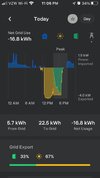@Vines
Do you know if the Tesla Powerwalls are better off exporting at max kW over a short duration, or exporting at 3 kW over a long duration? Like have you seen any advice/whitepaper stuff from Tesla measuring the impact to energy density or the on-board inverter or the cooling module?
For my system with 3x Powerwalls and about 39 kWh total. If I could reasonably predict that the 3x Powerwalls would drain down to 20% during the 9-hours-long EV2A shoulder + peak time (using 30 kWh so I'm left with 9 kWh)... would I be better off just having the batteries dump 30 kWh from 4pm to 6pm (15 kW x 2 hours)? Or does this stress the hell out of the Powerwalls if I did this every day?
Do you know if the Tesla Powerwalls are better off exporting at max kW over a short duration, or exporting at 3 kW over a long duration? Like have you seen any advice/whitepaper stuff from Tesla measuring the impact to energy density or the on-board inverter or the cooling module?
For my system with 3x Powerwalls and about 39 kWh total. If I could reasonably predict that the 3x Powerwalls would drain down to 20% during the 9-hours-long EV2A shoulder + peak time (using 30 kWh so I'm left with 9 kWh)... would I be better off just having the batteries dump 30 kWh from 4pm to 6pm (15 kW x 2 hours)? Or does this stress the hell out of the Powerwalls if I did this every day?
Last edited:



